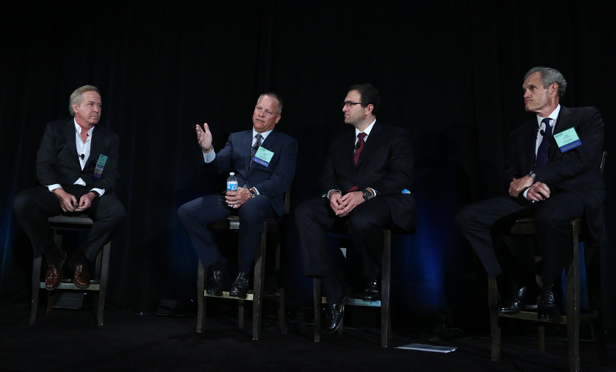 The Capital Markets panel at O.CON 2016.
The Capital Markets panel at O.CON 2016.
LOS ANGELES—There is so much changing in the office market, Scott Stuckman, executive managing director at USAA Real Estate Co., said to kick off the capital markets panel at NAIOP O.CON, adding most notably that traditional office buildings aren’t as successful as they once were. Stuckman moderated the panel for panelists Jay Borzi, senior managing director, Eastdil Secured; John Miller, senior managing director and regional director of Southern California at Tishman Speyer; and Kev Zoryan, managing director at Morgan Stanley.
According to the panelists, the demand for and development of creative office is the most significant trend dominating the market. Miller says the market for creative product is frothy, and he finds the best value comes from new construction creative office because rebuilding and renovating existing office space is very expensive. He also adds that creative office needs to shift from the concept of two-story buildings to concepts that utilize high-rise space. While the office market is shifting toward creative properties, Miller says, “the rise hasn’t lifted all boats,” and there is still demand for traditional office spaces.
It isn’t only creative office that is changing the market, but a fundamental shift in the way that people are using space, according to Zoryan. Densities are shifting immensely, and that has strengthened the performance of product in core markets. Borzi added that Los Angeles has become a hot market for investors, calling it the “darling of the office market across the country.” Everyone wants to be here, although it can be hard for some investors to find opportunities here because the deals are smaller than other core markets.
The demand for creative office has affected pricing. According to Borzi, creative office is now more expensive than traditional office space, and that is reflective of changing tenant needs and culture. Zoryan adds that tenant renovations are an equally valuable way to transition to creative office, one that landlords should consider as well.
You might also consider co-working spaces as part of the “fundamental shift” in the way that people are using space. The growing market for co-working spaces is not a concern of the panelists, however. Miller said that when an industry grows that quickly, it is hard to tell what will happen, adding that he doesn’t know what will happen to a business like co-working in a recession.
Looking more broadly at the office market, the sector has seen vacancies decrease, rising rental rates and strong fundamentals, especially in core markets.. Borzi said that commercial real estate returns remain stronger than other investment classes, using the example that CalPERS had a 1.4% return to investors this year. That makes a 4-cap look pretty good, he said on the panel.
Overall, the panelists said that the office market is healthy but plateauing. Miller says that they are starting to be more conservative in their underwriting on everything from rent growth to cap rates. Borzi, however, noted that office investors are still able to buy below replacement cost, which shows that there are still opportunities left in the market.

















 Copyright © 2024 ALM Global, LLC. All Rights Reserved.
Copyright © 2024 ALM Global, LLC. All Rights Reserved.